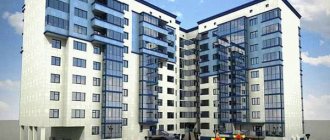How to recognize a house as unsafe is a question asked by owners who want to change their living space to a more comfortable one. But for this, an apartment building must be recognized as unsafe in accordance with the procedure established by law . The Soviet era left us a legacy of housing stock, which is in a deplorable state and is becoming more and more destroyed every year. Over the past 25 years, not much new housing has been built and, as a result, millions of square meters of emergency housing have been created, in which women, children and the elderly live. Many emergency houses are houses without amenities, in which even the toilet is located on the street. Since the beginning of a large-scale federal program for relocation from dilapidated housing, citizens living in unsuitable housing have a chance to improve their living conditions and get comfortable apartments.
In what cases is a house considered unsafe?
The definition of emergency housing is given by the Methodological Manual MDK 2-04.2004. This is a house in which load-bearing structures and more than half of the premises pose a danger to others.
The grounds for recognizing an object as emergency can be:
- natural wear and tear;
- influence of external factors;
- deformation;
- loss of design strength.
Expert opinion
Stanislav Evseev
Lawyer. Experience 12 years. Specialization: civil, family, inheritance law.
As a result of these impacts, strengthening measures must be taken. However, if the cost of restoration work exceeds the established standards, then the object is subject to demolition.
There is no need to confuse emergency and dilapidated housing. The main sign of dilapidation of a room is a high percentage of wear and tear. An object with a high percentage of wear and tear (70% or more) is considered dilapidated.
However, dilapidated housing does not pose a danger to the life and health of residents. While emergency - poses a danger to residents.
Thus, the dilapidated facility is subject to major repairs. And the emergency one is subject to demolition.
Basic Concepts
It is important to distinguish when a house can be considered unsafe and when it is considered dilapidated, since these are two big differences. Resettlement is not carried out from a dilapidated house - it is considered old, but suitable for living. The emergency premises are considered completely unsuitable for habitation.
The main requirements for an emergency house are its location in a dangerous or emergency area, a serious violation of sanitary standards and a threat to residents. In this case, it will be simply dangerous to stay in such a room any longer - hasty resettlement and demolition are being carried out.
Even if a private house, recognized as dilapidated, and the land plot under it are 75% uncomfortable, but do not threaten life and health, then resettlement will not take place. Therefore, most buildings in disgusting condition are still in use, awaiting recognition as unsafe.
Grounds for recognizing housing as unsafe
The grounds for recognizing a residential property as unsafe are set out in Decree of the Government of the Russian Federation No. 47 of 2006 (Chapter 3).
| No. | Premises considered dangerous and subject to demolition | Comments |
| 1 | Premises located under a garbage chute or waste disposal device | An apartment is considered unsafe if under it or in an adjacent room there is a device for flushing or cleaning the garbage chute |
| 2 | Premises with windows overlooking noisy traffic routes, if the noise level cannot be reduced | The maximum permissible noise level is 55 dB during the day and 45 dB at night |
| 3 | Premises located in houses that suffered from natural disasters and cataclysms | The main condition is the unprofitability of repair work |
| 4 | Objects located close to overhead power lines | The maximum voltage value cannot exceed 1 kV/m, and the induction value cannot exceed 50 µT at an industrial frequency of 50 Hz |
| 5 | Objects located in the zone of possible man-made disasters | If it is impossible to protect the residential premises from destruction |
| 6 | Objects located in the zone of landslides, mudflows, avalanches or subject to flooding | An exception is the situation when flooding can be prevented with the help of engineering structures |
| 7 | Premises located in areas with negative sanitary and epidemiological indicators (electromagnetic fields, noise, vibration), if the indicators exceed the standards for citizens’ residence | These also include facilities located in areas of transport and engineering infrastructure, production and sanitary protection zones. |
| 8 | Apartment buildings with deformed foundations | These also include objects with deformed walls and wooden structures |
| 9 | Objects with a significant percentage of physical wear and tear, if this has led to the impossibility of safe use for residential purposes | If the level of reliability of supporting structures is significantly reduced, as a result of which strength and reliability are reduced |
Important! In everyday life, it is believed that housing can be considered unsafe due to its age. However, in practice, the age of the residential premises has no relation to establishing the breakdown of the apartment. The main sign is wear and tear.
In addition, the following indicators are not grounds for recognizing an object as dangerous:
- Lack of an elevator and garbage chute in an apartment building with more than 5 storeys.
- Compliance of the space-planning solution with outdated regulations, if this does not interfere with the normal operation of the facility.
- Lack of water supply and sewerage in the house, up to 2 storeys.
How to challenge the commission's decision?
Let's face it: residents face a difficult task. You will have to run around the bureaucratic offices and personally study the regulatory framework of the issue.
Sometimes they initiate legal proceedings, since by hook or by crook the administration seeks to save its budget.
Important. Disputes arising with resettlement are resolved by the district court.
Judicial practice shows that the parties mainly dispute:
- inaction of the municipality after the applicants’ appeal;
- decisions of interdepartmental commissions regarding recognition of real estate as emergency, proposed measures;
- extended resettlement periods;
- unequal replacement or underestimation of the actual cost of housing when issuing compensation.
The procedure for recognizing housing as unsafe
Responsibilities for recognizing residential facilities as unsafe are assigned to local governments. Each municipality is obliged to form a specialized commission under the housing committee of the local administration.
The composition and work of the interdepartmental commission are approved by a resolution of the local government body.
The powers of the interdepartmental commission for recognizing housing as unsafe include:
- acceptance of documents;
- defining a list of additional documentation;
- recruitment of experts;
- inspection of the facility;
- making a decision to recognize the house as unsafe;
- refusal to assign an emergency status to an object.
The initiation of the process rests with the residents or owners. Local government specialists are not required to independently inspect each house without the residents’ application.
Procedure:
- Collection of documentation.
- Contacting the authorized body.
- Receipt of the act.
What documents are needed for registration?
The preparation of documents for recognition of housing as unsafe is established by local regulations of the municipality. The general list is contained in Decree of the Government of the Russian Federation No. 47 of 2006 (Article 45).
List of documentation:
- A copy of the applicant’s title document for housing. The document is provided if the right is not registered in the Unified State Register of Real Estate. Otherwise, the document is requested by the commission specialist at Rosreestr independently.
- A copy of the applicant's civil passport.
- Application for assignment of status to residential premises.
- Conclusion of the authorized organization that conducted the examination.
- Official complaints from residents about living conditions to the competent authorities.
- Certificate of recognition of the house as unsafe.
- Technical plan.
Contacting the authorized body
The owner or tenant of a residential premises can submit an application individually or collectively.
Ways to contact the authorized body:
- personally;
- by mail;
- through the MFC;
- through a representative;
The municipal service of assigning an object the status of emergency housing is provided free of charge. The period for its provision cannot exceed 30 days.
If documents are sent by mail, then it is necessary to attach a list of the attachments of the documents being sent.
If the application is submitted through a representative, then he must have documents confirming his authority:
- notarized power of attorney (representative of an adult citizen);
- birth certificate, certificate of guardian, trustee, adoptive parent (if the owner is a minor);
- resolution on the appointment of a guardian (if the owner is incapacitated).
Receiving the act
The result of contacting the authorized body is:
- issuance of an inspection report on the applicant’s living conditions;
- issuance of an act recognizing the object as unsafe or refusal to assign status.
The method of issuing the result is chosen by the applicant when filing a claim.
Possible options:
- personally;
- by mail;
- through the MFC;
- through a representative.
From the moment a positive response is received, owners and tenants of residential premises have the right to be resettled in safe facilities under the housing program.
Shared privatization
If the plot was privatized for several people, then when preparing documents for a new apartment, the shared ownership in it will be calculated according to the property in the former plot.
If the site under the house in question is already private property, it does not require privatization. If it is state or municipal land, it must first be privatized. But before this, mandatory privatization of the house is required, even if it is in disrepair. A privatized house is the main reason for privatizing the land underneath it.
Often executive bodies try to delay resolving issues of this nature. This is due, to a large extent, to the fact that the housing stock is not enough to relocate all the residents of dilapidated buildings in Russia.
Refusal to issue an act
If the interdepartmental commission made a decision to refuse to recognize the facility as unsafe, the applicant has the right to appeal such a decision.
Appeal procedure:
- Pre-trial . The applicant files a claim, which is sent to the head of the municipality. The results of the examination and the refusal of the interdepartmental commission are attached to the complaint. The application is reviewed within 30 days.
- Judicial . After receiving a response from the head of local government, it is necessary to prepare a statement of claim to the district or city court. The application must contain a requirement to challenge the act of the local administration and to recognize the house as dangerous for citizens to live in.
The residential building will be declared unsafe by a court decision. If there are grounds, the court will oblige the local government body to include the property on the resettlement list.
What you need
A house that is in real emergency, and which according to documents belongs to the housing stock as complete and safe, must be recognized as unfit for use. The requirement to recognize an accident may be put forward by:
- Owner of residential property;
- Tenant of the property;
- Authorized bodies - Rospotrebnadzor, housing and fire inspections.
A corresponding application is submitted to these authorities, and the work of the commission begins. If the house is unfit for use, a conclusion is prepared, and on its basis resettlement is carried out.
This is how the procedure should ideally proceed, but in practice it is significantly delayed. If the owner of the house and the plot underneath it does not agree with the commission’s decision, it is possible to challenge it within three months from the date of its adoption.
To do this, you need to go to court, but you need strong arguments to challenge it. An independent examination of the house and plot that has been privatized should be ordered. The expert’s conclusion will become the main argument in court.
The house was declared unsafe, what to do next? How to get a new apartment or house?
The main consequence of recognizing housing as unsafe is the inclusion of owners and tenants of residential premises in the resettlement program. In 2021, the program is being implemented throughout the Russian Federation.
Funds for housing provision are allocated on the basis of co-financing from the federal and local budgets. Every year, regional authorities create lists to include citizens in the list of those in need of resettlement.
Provision is provided in order of priority. The program is being implemented very slowly. For example, as of 2021, 802 houses in the Novosibirsk region were recognized as unsafe. Since 2015, residents of 182 houses (1,800 people) have been provided with housing.
Therefore, the issue of recognizing the house as an emergency owner must be initiated independently. Delay significantly delays the fact of obtaining a new living space.
The program provides for the provision of residential premises to owners of apartments in dilapidated buildings. The owner has the right to an apartment worth no more than the residual value of the housing.
If the proposed housing exceeds the cost of the emergency one, then the owner must pay extra. Otherwise, the property will be provided under a social rental agreement.
Important! In accordance with the Supreme Court ruling of 2017 No. 6-KG17-8, the owner has the right to choose between providing alternative living space and providing compensation.
The tenant has the right to similar living space. If the administration cannot provide alternative housing, then the citizen can get a larger apartment.
However, the area is calculated based on the total area of emergency housing, and not on the provision rate per person (Definition of the Supreme Court of 2021 No. 10-КГ17-7).
In the event of a threat of collapse, housing must be provided to the tenant immediately (Definition of the Supreme Court of 2021 No. 70-KG17-22).
Let's consider what owners should do.
The owner of a residential premises must:
- Collect documents.
- Contact your local administration.
- Obtain a decree recognizing someone in need of improved housing conditions.
- Submit documents for inclusion in the program.
If the owner refuses to evict, the administration has the right to initiate legal proceedings for forced eviction. In this case, the citizen will not receive alternative housing, but compensation. The payment is equal to the residual value of the apartment (Definition of the Supreme Court of 2021 No. 5-КГ18-19).
How to officially recognize housing as unsatisfactory?
By what criteria can housing be classified as unsafe?
An examination of the building and its premises by an interdepartmental commission will be required (Article 15 of the Housing Code of the Russian Federation). This is not a one-day procedure, since several actions are carried out:
- Instrumental control.
- Laboratory research.
- Design, survey and specialized examinations.
- Data analysis with commission verdict.
The result of the work of state representatives is an act of the established form. The document reflects:
- the current state of the object, its engineering and structural elements;
- characteristics of the adjacent territory;
- details of deviations from standards identified during the research: instrument readings, instrumental measurements;
- assessment of expert results: whether safe operation of the building or its reconstruction/repair is possible, whether relocation of residents is required.
The results of the examinations are prepared in writing by specialists and attached to the report.
From a complaint to receiving the keys to a new apartment: actions of the owners
The persistence of applicants for resettlement must go “hand in hand” with a clear algorithm of actions. To do this, let us turn to Section IV of the government decree:
- the owner sends an application and a package of documentation to the administration of the “register” of the building;
- responsible persons are determined with additional papers and stages of home inspection;
- the municipality creates an interdepartmental commission and attracts experts to the work;
- a set of measures is being carried out to assess the building, design and survey work. If the building is multi-apartment, each apartment is inspected. After completing the practical part, a report is drawn up.
The results of the inspection with proposals for relocation or reconstruction of the house are communicated to the applicant, local authorities, and interested supervisory authorities. All information must be sent to the recipients by official written communication.
Important. The homeowner has the right to participate in the inspection of the house in an advisory capacity.
What documents must the owner prepare?
Who recognizes the house as unsafe?
An application supported by a package of documents is sent to the housing commission of the municipality:
- Notarized copies of the grounds for ownership/ownership.
- Technical passport of the apartment, cadastral plan of the premises.
- Previously submitted applications with responses from officials, results of surveys.
- Certificates and extracts that facilitate an objective consideration of the issue on its merits.
After receiving the application, officials are required to create an interdepartmental commission within a month.
Residents' rights
Current legislation suggests that instead of housing in a dilapidated building, a citizen is given a new apartment. At the same time, certain requirements are imposed on the new residential premises. Thus, apartments must be provided with sanitary communications, they must have a clean finish . In other words, housing must be suitable for living without additional material investments on the part of the resettled person.
In addition, it is established that the new apartment must have an equal or slightly larger area than it was previously. It is also possible to provide housing with a significantly larger area, but subject to additional payment by the citizen.
As for the location of the apartment for relocation, it must be located within the same municipality in which the old housing was located.
The owners of the residential premises of the house being demolished have the right to independently choose the form in which their rights will be ensured. They can choose to move to a new comfortable apartment or receive monetary compensation.
Tenants of municipal apartments can only count on moving to new housing. There is no option for them to choose monetary compensation.









